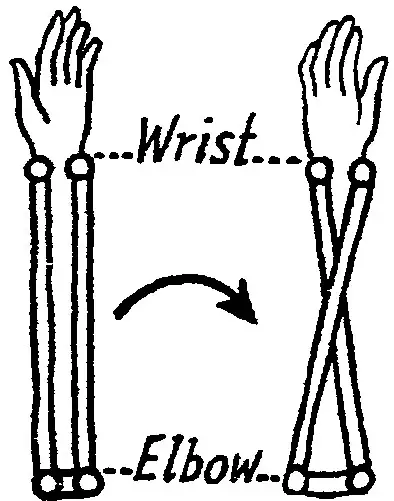Nature of Action
Strictly speaking, there is no such thing as true forearm rotation.
During "rotation" the forearm itself rotates as a whole, with the elbow acting as a pivot as perceived by the human eye.
The fact is, that you can only "rotate" the forearm at its wrist-end, and the wrist-joint and hand turn along with the forearm.
The fingers move only in cooperation with the forearm. You can only rotate about half a turn or 180 degrees.
It is a process by which the 1) ulna and 2) radius of the forearm cross and uncross.
The forearm consists of two bones, normally lying side by side. These are pivoted both at the elbow and wrist joint.
You can feel their position by touching the elbow and the hand at the wrist.
Now, when you rotate your hand into its playing position, palm downwards, you twist the outer of these two bones, the "radius" upon the inner bone, the "ulna," just as you can twist one finger over another. In this way you obtain that partial rotation of the wrist by which the hand is swung over into its playing position.
Now, when you rotate your hand into its playing position, palm downwards, you twist the outer of these two bones, the "radius" upon the inner bone, the "ulna," just as you can twist one finger over another. In this way you obtain that partial rotation of the wrist by which the hand is swung over into its playing position.

- Supination and Pronation of the left hand
- Ulna and radius of the left arm
Use Rotation to bring the hand into the correct Position
Obviously, everyone is compelled to make this rotary motion to bring the hand into the correct playing position palm downwards.
Each pianist is also compelled to continue a slight (although now invisible) exertion (rotationally) to retain his hand in a level position.
When balanced on the surface of the keys, the hand itself may be lying somewhat loose and inactive on the keyboard.
Moreover, to sound a thumb note strongly, the player is compelled momentarily to increase the rotary exertion of the forearm inwards,
so that the thumb may be adequately assisted to move its key down efficiently.
Double Muscular Action
Evidently we also possess "strong" and "weak" musdes rotationally, just as in the case of the finger.
The hand is evidently turned over into its playing-position (or "supination") by the exertion of both the "strong" and "weak" muscles used during the process of forearm rotation. Considering that the "weak" muscles evidently suffice to retain the position of the hand balanced on the surface of the keys, the "strong" muscles may therefore promptly and completely stop work.
Using the Thumb
To help the thumb to sound its note, a momentary action of the "strong" muscles is needed.
The application of these "strong" muscles is therefore always intermittent and momentary. Whereas the action of the "weak" muscles may be continuous for a time. Realize also, that even when playing forte, it is a gentle exertion of the forearm rotationally which is required.
This is not noticeable unless attention is drawn to it. The exertions used in playing should be smooth and coordinated.